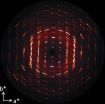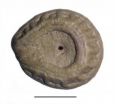(Press-News.org) A route for constructing protein nanomachines engineered for specific applications may be closer to reality.
Biological systems produce an incredible array of self-assembling, functional protein tools. Some examples of these nanoscale protein materials are scaffolds to anchor cellular activities, molecular motors to drive physiological events, and capsules for delivering viruses into host cells.
Scientists inspired by these sophisticated molecular machines want to build their own, with forms and functions customized to tackle modern-day challenges.
The ability to design new protein nanostructures could have useful implications in targeted delivery of drugs, in vaccine development and in plasmonics -- manipulating electromagnetic signals to guide light diffraction for information technologies, energy production or other uses.
A recently developed computational method may be an important step toward that goal. The project was led by the University of Washington's Neil King, translational investigator; Jacob Bale, graduate student in Molecular and Cellular Biology; and William Sheffler in David Baker's laboratory at the University of Washington Institute for Protein Design, in collaboration with colleagues at UCLA and Janelia Farm.
The work is based in the Rosetta macromolecular modeling package developed by Baker and his colleagues. The program was originally created to predict natural protein structures from amino acid sequences. Researchers in the Baker lab and around the world are increasingly using Rosetta to design new protein structures and sequences aimed at solving real-world problems.
"Proteins are amazing structures that can do remarkable things," King said, "they can respond to changes in their environment. Exposure to a particular metabolite or a rise in temperature, for example, can trigger an alteration in a particular protein's shape and function." People often call proteins the building blocks of life.
"But unlike, say, a PVC pipe," King said, "they are not simply construction material." They are also construction (and demolition) workers -- speeding up chemical reactions, breaking down food, carrying messages, interacting with each other, and performing countless other duties vital to life.
Reporting in the June 5 issue of Nature, the researchers describe the development and application of new Rosetta software enabling the design of novel protein nanomaterials composed of multiple copies of distinct protein subunits, which arrange themselves into higher order, symmetrical architectures.
With the new software the scientists were able to create five novel, 24-subunit cage-like protein nanomaterials. Importantly, the actual structures, the researchers observed, were in very close agreement with their computer modeling.
Their method depends on encoding pairs of protein amino acid sequences with the information needed to direct molecular assembly through protein-protein interfaces. The interfaces not only provide the energetic forces that drive the assembly process, they also precisely orient the pairs of protein building blocks with the geometry required to yield the desired cage-like symmetric architectures.
Creating this cage-shaped protein, the scientists said, may be a first step towards building nano-scale containers. King said he looks forward to a time when cancer-drug molecules will be packaged inside of designed nanocages and delivered directly to tumor cells, sparing healthy cells.
"The problem today with cancer chemotherapy is that it hits every cell and makes the patient feel sick," King said. Packaging the drugs inside customized nanovehicles with parking options restricted to cancer sites might circumvent the side effects.
The scientists note that combining just two types of symmetry elements, as in this study, can in theory give rise to a range of symmetrical shapes, such as cubic point groups, helices, layers, and crystals.
King explained that the immune system responds to repetitive, symmetric patterns, such as those on the surface of a virus or disease bacteria. Building nano-decoys may be a way train the immune system to attack certain types of pathogens.
"This concept may become the foundation for vaccines based on engineered nanomaterials," King said. Further down the road, he and Bale anticipate that these design methods might also be useful for developing new clean energy technologies.
The scientists added in their report, "The precise control over interface geometry offered by our method enables the design of two-component protein nanomaterials with diverse nanoscale features, such as surfaces, pores, and internal volumes, with high accuracy."
They went on to say that the combinations possible with two-component materials greatly expand the number and variety of potential nanomaterials that could be designed.
It may be possible to produce nanomaterials in a variety of sizes, shapes and arrangements, and also move on to construct increasingly more complex materials from more than two components.
The researchers emphasized that the long-term goal of such structures is not to be static. The hope is that they will mimic or go beyond the dynamic performance of naturally occurring protein assemblies, and that eventually novel molecular protein machines could be manufactured with programmable functions.
The researchers pointed out that although designing proteins and protein-based nanomaterials is very challenging due to the relative complexity of protein structures and interactions, there are now more than a handful of laboratories around the world making major strides in this field. Each of the leading contributors have key strengths, they said. The strengths of the UW team is in the accuracy of the match of the designed proteins to the computational models and the predictability of the results.
INFORMATION:
This project was supported with funding from the Howard Hughes Medical Institute, the National Science Foundation, the International Vaccine Initiative, the U.S. Air Force Office of Scientific Research, and the U.S. Department of Energy.
Design of self-assembling protein nanomachines starts to click
A nanocage builds itself from engineered components
2014-06-05
ELSE PRESS RELEASES FROM THIS DATE:
Study discovers the downside of African-American success stories
2014-06-05
African-Americans such as Brown University President Ruth Simmons, Nobel Laureate Toni Morrison, and of course President Barack Obama have reached the pinnacle of success in historically white domains. But a new study finds there is a downside to African-American success stories: these positive examples prompt white Americans to think less successful African-Americans simply need to apply more effort to achieve their own success.
The findings are reported in the paper, "If He Can Do It, So Can They: Exposure to Counterstereotypically Successful Exemplars Prompts Automatic ...
Has solar activity influence on the Earth's global warming?
2014-06-05
A recent study demonstrates the existence of significant resonance cycles and high correlations between solar activity and the Earth's averaged surface temperature during centuries. This provides a new clue to reveal the phenomenon of global warming in recent years.
Their work, entitled "Periodicities of solar activity and the surface temperature variation of the Earth and their correlations" was published in CHINESE SCIENCE BULLETIN (In Chinese) 2014 No.14 with the co-corresponding authors of Dr. Zhao Xinhua and Dr. Feng Xueshang from State key laboratory of space weather, ...
Gestures research suggests language instinct in young children
2014-06-05
Young children instinctively use a 'language-like' structure to communicate through gestures.
Research led by the University of Warwick suggests when young children are asked to use gestures to communicate, their gestures segment information and reorganise it into language-like sequences. This suggests that children are not just learning language from older generations, their preference for communication has shaped how languages look today.
Dr Sotaro Kita from Warwick's Department of Psychology led the study with Dr Zanna Clay at the University of Neuchatel, Ms Sally ...
Understanding active pharmaceutical ingredients
2014-06-05
Active pharmaceutical ingredient (API), is the term used to refer to the biologically active component of a drug product (e.g. tablet, capsule). Drug products are usually composed of several components. The aforementioned API is the primary ingredient. Other ingredients are commonly known as "excipients" and these substances are always required to be biologically safe, often making up a variable fraction of the drug product. The procedure for optimizing and compositing this mixture of components used in the drug is known as "formulation". For example, if the API is a solid ...
Bloodstream infections reduced through better central line care at three hospitals
2014-06-05
Anaheim, Calif., June 5, 2014 – Whether through the use of alcohol-containing caps or basic cleaning of the injection port of the central line, infection preventionists at three hospitals are finding successful ways to stop germs from entering central line catheters and causing bloodstream infections in patients.
A trio of abstracts, to be presented on June 7 at the 41st Annual Conference of the Association for Professionals in Infection Control and Epidemiology (APIC), addresses the challenge of keeping bacteria from entering the bloodstream through a central line, a ...
Molecular self-assembly scales up from nanometers to millimeters
2014-06-05
To ensure the survival of Moore's law and the success of the nanoelectronics industry, alternative patterning techniques that offer advantages beyond conventional top-down patterning are aggressively being explored.
Can self-assembly based technologies offer advantages beyond conventional top-down lithography approaches?
A joint effort of the Aalto University of Helsinki, the Politecnico di Milano, and VTT Technical Research Centre of Finland has now demonstrated that it is possible to align molecular self-assemblies from nanometers to millimeters without the intervention ...
Northern Ireland Assembly to receive policy recommendations
2014-06-05
YOUNG people from disadvantaged communities in Northern Ireland should be provided with "safe spaces" in which to protest and make their views known. This would help prevent them falling under the sway of extremists, argue researchers at the University of Huddersfield who played a major role in organising a conference in Belfast that investigated the "culture wars" of Ulster.
One of the key themes to emerge was that many working-class communities felt they had gained little from the province's "peace dividend", with jobs hard to find and segregation still common. As a ...
Doing more means changing less when it comes to gene response, new study shows
2014-06-05
Turku, FI – An international team led by scientists at the University of Turku in Finland studied thermally-adapted fish populations to discover that the more biological functions a gene has, the less it responds to environmental change. "In addition to having important implications for climate change adaptation, these findings could radically change the way we study gene responses to any external stimulus like for example to drug treatments", the authors suggest. Their findings are reported on June 3 2014 in the journal Nature Communications.
When organisms need more ...
A sand-dwelling new species of the moonseed plant genus Cissampelos from the Americas
2014-06-05
Researchers from the Missouri Botanical Garden have discovered in dry forests and transient sand dunes in Bolivia and Paraguay, a new plant species in the moonseed family Menispermaceae. The discovery was reported in the open access journal PhytoKeys.
The new species was described in the genus Cissampelos, which includes vining species that for the most part are found in disturbed habitats of the tropical and subtropical regions of the World.
This new Cissampelos is morphologically unique by its small leaves, its 8 anther-cells in the male flowers, and a large endocarp–a ...
Scientists discover the basis of allergic reactions
2014-06-05
Allergies in humans and animals are on the increase. An allergic reaction may cause unpleasant symptoms like hay fever, food intolerance or skin rashes. Allergic reactions may also cause acute and life-threatening symptoms, such as asthma or anaphylactic shock.
A single pollen protein is responsible for allergies
One of the most well known allergens, i.e. substances that cause allergies, is so-called "Bet v 1" from birch pollen (Betula verrucosa). The protein was first produced artificially in the laboratory 25 years ago in Vienna, and is being used as an allergen ...
LAST 30 PRESS RELEASES:
NSF–DOE Vera C. Rubin Observatory spots record-breaking asteroid in pre-survey observations
Ribosomal engineering creates “super-probiotic” bacteria
This self-powered eye tracker harnesses energy from blinking and is as comfortable as everyday glasses
Adverse prenatal exposures linked to higher rates of mental health issues, brain changes in adolescents
Restoring mitochondria shows promise for treating chronic nerve pain
Nature study identifies a molecular switch that controls transitions between single-celled and multicellular forms
USU chemists' CRISPR discovery could lead to single diagnostic test for COVID, flu, RSV
Early hominins from Morocco reveal an African lineage near the root of Homo sapiens
Small chimps, big risks: What chimps show us about our own behavior
We finally know how the most common types of planets are created
Thirty-year risk of cardiovascular disease among healthy women according to clinical thresholds of lipoprotein(a)
Yoga for opioid withdrawal and autonomic regulation
Gene therapy ‘switch’ may offer non-addictive pain relief
Study shows your genes determine how fast your DNA mutates with age
Common brain parasite can infect your immune cells. Here's why that's probably OK
International experts connect infections and aging through cellular senescence
An AI–DFT integrated framework accelerates materials discovery and design
Twist to reshape, shift to transform: Bilayer structure enables multifunctional imaging
CUNY Graduate Center and its academic partners awarded more than $1M by Google.org to advance statewide AI education through the Empire AI consortium
Mount Sinai Health system receives $8.5 million NIH grant renewal to advance research on long-term outcomes in children with congenital heart disease
Researchers develop treatment for advanced prostate cancer that could eliminate severe side effects
Keck Medicine of USC names Christian Pass chief financial officer
Inflatable fabric robotic arm picks apples
MD Anderson and SOPHiA GENETICS announce strategic collaboration to accelerate AI-driven precision oncology
Oil residues can travel over 5,000 miles on ocean debris, study finds
Korea University researchers discover that cholesterol-lowering drug can overcome chemotherapy resistance in triple-negative breast cancer
Ushikuvirus: A newly discovered giant virus may offer clues to the origin of life
Boosting the cell’s own cleanup
Movement matters: Light activity led to better survival in diabetes, heart, kidney disease
Method developed to identify best treatment combinations for glioblastoma based on unique cellular targets
[Press-News.org] Design of self-assembling protein nanomachines starts to clickA nanocage builds itself from engineered components




